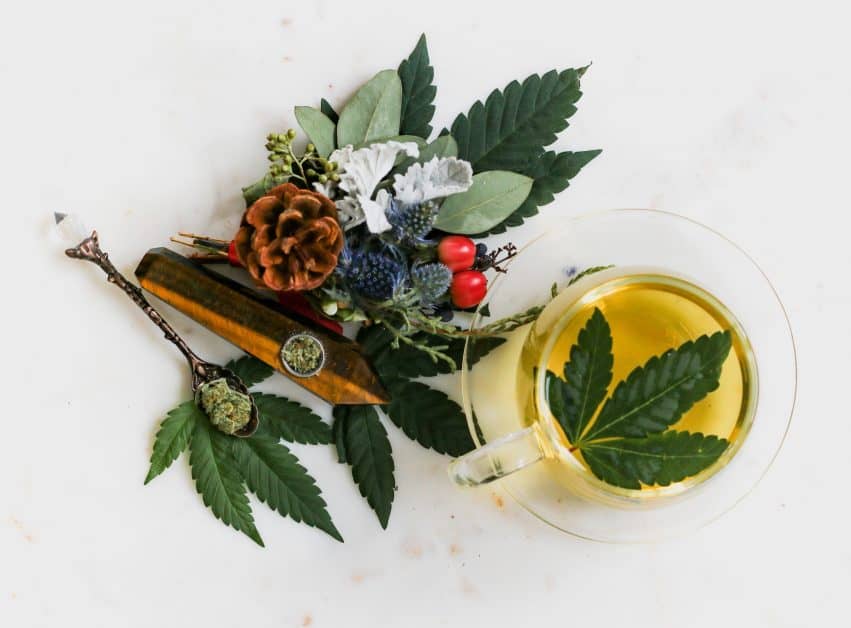Home > Hormones > Hormone health & solutions > Herbal Tea Recipe To Cure a Cold – Why Herbal Tea Is Your Winner To Beat Cold This Winter


Cold season is upon us, runny noses and sore throats. And whilst, out there is a whole host of medicine to help fight cold symptoms, the constant input of chemicals into our bodies isn’t really that great to think about, and so many other options are often too expensive to help keep you feeling great throughout the entire, and very long, English winter.
And true to my upbringing, I honestly believe that there is nothing a good cup of tea can’t fix. So instead of relying completely on tablets, or those drinks that sound like they should be great but are in fact garishly yellow and taste like cough drops, go back to the wisdom of nature, and try a handmade herbal recipe, packed with all the flowers and plants to battle your symptoms, all within a nice warming cup of tea.
Herbs have been used in just about every culture around the world for centuries, overlooked nowadays by western medicine, the benefits and impact certain plants have on our bodies cannot be ignored. From immune systems and women’s health to skincare and mental health, there is a simple remedy for almost every complaint the human body could throw at you.
Herbal teas are regularly enjoyed as a caffeine free alternative these days, for winding down at night, easing anxiety or settling stomachs, different blends can achieve difficult results. For colds, most recipes you can find will centre around three herbs:
This blend is a long lasting and well recognised one, believed to based on an old Gypsy recipe for treating fevers.
Most of us will know elderflower, commonly found growing along British hedgerows, you can recognise it from its clusters of white flowers in the spring, and dark berries. Peppermint can grow pretty much anywhere but cultivated plants often have a higher oil content than wild ones so if you can, grow your own. Yarrow is as equally available, growing across the world and flowering in the late spring and early summer, clusters of white flowers similar to elderflowers. In Hebrides folklore, holding a yarrow leaf to your eye was said to give you second sight. So, a useful plant all round, really.
Simply infuse about a teaspoon of each into some boiling water and enjoy, use lemon or honey to taste if you want it, then curl up with your tea and let it get to work. As well as bringing down your fever, this tea will give your immune system a healthy boost, helping to prevent further colds.
If you don’t grow and dry out your own herbs, make sure you get them from sustainable, good places.
Note: If you are pregnant, breastfeeding, or trying to conceive, speak to a qualified professional before using yarrow. Yarrow is also toxic to dogs and cats so keep it out of paws reach, it won’t kill them but might cause vomiting, diarrhoea or dermatitis.
Disclaimer: This website does not provide medical advice. The information, including but not limited to, text, graphics, images and other material contained on this website are for informational purposes only. No material on this site is intended to be a substitute for professional medical advice, diagnosis, or treatment. Always seek the advice of your physician or other qualified healthcare provider with any questions you may have regarding a medical condition or treatment, and before undertaking a new healthcare regimen, and never disregard professional medical advice or delay in seeking it because of something you’ve read on this website.

-


Dr Singh is the Medical Director of the Indiana Sleep Center. His research and clinical practice focuses on the myriad of sleep.

What vaginal discharge colors mean for your health Understanding vaginal discharge colors and meaning is essential for every woman at every stage of life. While some colored discharge may indicate infections, others are normal. White and clear The first discharge

Understanding perimenopause and menopause When talking about perimenopause versus menopause, it’s easy to confuse these two stages. Perimenopause is the transitional period when you move away from your peak fertility and your ovaries gradually stop releasing eggs. In turn, menstruation

Understanding perimenopause and its symptoms When it comes to aging, many women know about menopause but are surprised to learn about the transitional stage leading up to it, called perimenopause. There are three stages of perimenopause: early, late, and menopause,
| Cookie | Duration | Description |
|---|---|---|
| cookielawinfo-checkbox-analytics | 11 months | This cookie is set by GDPR Cookie Consent plugin. The cookie is used to store the user consent for the cookies in the category "Analytics". |
| cookielawinfo-checkbox-functional | 11 months | The cookie is set by GDPR cookie consent to record the user consent for the cookies in the category "Functional". |
| cookielawinfo-checkbox-necessary | 11 months | This cookie is set by GDPR Cookie Consent plugin. The cookies is used to store the user consent for the cookies in the category "Necessary". |
| cookielawinfo-checkbox-others | 11 months | This cookie is set by GDPR Cookie Consent plugin. The cookie is used to store the user consent for the cookies in the category "Other. |
| cookielawinfo-checkbox-performance | 11 months | This cookie is set by GDPR Cookie Consent plugin. The cookie is used to store the user consent for the cookies in the category "Performance". |
| viewed_cookie_policy | 11 months | The cookie is set by the GDPR Cookie Consent plugin and is used to store whether or not user has consented to the use of cookies. It does not store any personal data. |
